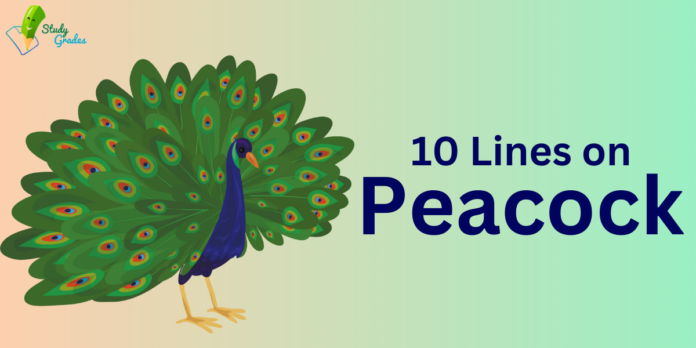The peacock is the national bird of India. It is known for its striking beauty and allure. In Hinduism, the peacock holds sacred significance and is often mentioned in religious texts. It is also the mount of Lord Kartikeya. Revered as the “king of birds,” the peacock is depicted with a crown placed by the creator of the universe. Peacocks have captivated human interest for centuries. There are two primary species: the blue peacock, which inhabits India and Sri Lanka, and the green and Java peacocks, found in Myanmar and Java. The Congo peacock, discovered in 1936 after a feather was found in 1913, adds to the diversity of this species. While all peacocks are stunning, each has its unique identity.
10 Lines on Peacock
- The scientific name of the peacock, a member of the Phasianidae family, is Pavo cristatus. In English, it is referred to as the “Blue Peafowl” or “Peacock,” while in Sanskrit, it is called “Mayur.”
- During the rainy season, when a peacock spreads its wings against dark clouds, it appears as though it is wearing a royal robe adorned with diamonds. Due to its exceptional beauty, the Indian government declared the peacock the national bird on January 26, 1963.
- Peacocks are also considered beneficial to farmers because they consume pests such as rats, insects, lizards, and snakes from fields. Their diet primarily includes grains like gram, wheat, and millet, as well as fruits and vegetables such as brinjal, guava, pomegranate, tomato, and onion.
- Historical records show that peacocks were highly valued by kings and emperors. For example, the coins from the reign of Emperor Chandragupta Maurya featured a peacock on one side.
- The throne used by Mughal Emperor Shah Jahan was designed to resemble a peacock, reflecting the bird’s association with opulence and grandeur.
- Peacocks are abundant in India and Sri Lanka. Although they are wild birds by nature, their search for food sometimes brings them into proximity with human settlements.
- Peacocks have a lifespan of 25 to 30 years. The male peacock can reach a length of about 215 cm and a height of around 50 cm, while the female measures approximately 95 cm. A male peacock boasts about 150 decorative feathers, which the female lacks.
- The male peacock has a prominent crest on its head, while the female has a smaller, less pronounced tuft. The male is distinguished by its long, ornate tail feathers.
- The peacock’s dance during the rainy season is so captivating that it inspires many to join in. As part of this display, some feathers may shed. Each August, peacocks molt their feathers, which regrow before summer arrives.
- Peacocks are gradually becoming endangered, leading to stricter protections. In 1972, the Indian government enacted the Peacock Protection Act to safeguard and increase the peacock population.
10 Lines on Peacock in English for class 4
- The peacock is the national bird of India and is known for its colorful feathers.
- The male peacock has a beautiful tail with many eye-like patterns, which it spreads out during courtship dances.
- Peacocks are very big birds with long legs and a small head with a crest of feathers.
- They can be found in India, Sri Lanka, Myanmar, and Java.
- The peacock’s feathers are bright blue, green, and gold, making it look like it’s wearing a royal costume.
- In Hinduism, the peacock is considered a sacred bird and is the ride of Lord Kartikeya.
- Peacocks eat a variety of foods, including insects, fruits, and seeds.
- They usually live for 25 to 30 years and are known for their loud calls and impressive displays.
- Peacocks shed their feathers once a year and grow new ones before summer.
- The Indian government protects peacocks to help keep their population safe and healthy.
How do you write 10 lines on a peacock?
To write 10 lines on a peacock, you should know the specialities of a peacock, how they help people, where they live, what they eat and more.
Important Links
| Essays | Careers | Results |
| Admit Card | Admission | Latest Education News |
Stay Connected With StudyGrades for Latest Updates on Board Results!





























